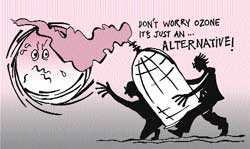

Attempts are on to find replacements for deadly ozone depleting substances (ODS) such as chlorofluorocarbons (CFCs)


 research on finding safer substitutes for ods like cfcs, halons, and carbontetrachloride are underway. In fact certain replacements have already been made and are successfully being used.
research on finding safer substitutes for ods like cfcs, halons, and carbontetrachloride are underway. In fact certain replacements have already been made and are successfully being used.
cfcs are regarded as being harmful because they damage the ozone layer which helps screen out damaging ultraviolet rays emitted by the sun from reaching the Earth. The degradation of this layer can cause an increase in the occurrence of skin cancer and a reduction in crop yields. Some scientists believe that a severe enough denudation of the layer could lead to the elimination of many species. The phasing out of cfcs was initiated in the '70s with the emergence of scientific evidence regarding the damaging nature of these compounds. It was found that cfcs escaping from junked compressors and hoses rise up to the stratosphere where ultraviolet radiation transforms them into chlorine atoms which in turn play a role in ozone depletion.
cfcs refer to a variety of hydrocarbon derivatives. The most widely-used is cfc-12. It is primarily a refrigerant in refrigerators and mobile air conditioners. Other cfcs like 11, 113, 114, and 115, are used for the production of foam, rubber, as rigid insulating foam in appliances, and as solvents, especially in the electronics industry.
According to the available statistics, India happens to produce and use seven of the twenty cfcs whose use was controlled by the Montreal Protocol. The cfcs brought under the limelight at Montreal are being replaced with hydroflurocarbons (hfcs) and hydrochloroflurocarbons (hcfcs). Among the replacements being made, hcfc-123 is being considered as a substitute for cfc-11, used in foam-blowing applications. The American automobile industry has made a complete switch to hfc-134 a from having used cfc-12 for the purpose of air-conditioning. hcfc-22, which has always been used in residential central air-conditioning units, is now being used in large commercial chillers and for commercial refrigeration. Even though cfcs may be getting replaced with hcfcs, the latter are also capable of depleting the Earth's ozone layer, albeit at a considerably slower rate than cfcs.
To concentrate on this problem, the Copenhagen session of the Montreal protocol held in 1992, adopted a phase out schedule for hcfcs. The agreement calls for the reduction of hcfcs in five stages beginning in the year 2004, with a total phase out planned by the year 2030. Even though the hfcs have not been associated with ozone depletion, both hfcs and hcfcs have recently been cited as possible culprits responsible for acid rain. "The atmospheric degradation of hcfcs is expected to produce trifluoroacetate (tfa), which is removed from the atmosphere mainly by rain," said T K Tromp and his colleagues at Atmospheric and Environmental Research Incorporated in Cambridge, Massachusetts, us. Apparently, tfa -- which is non-biodegradable -- is posing no lesser an ecological threat. Its gradual build up is endangering wetlands which are known as havens of biodiversity. Even though the present level of accumulation is not a major cause for alarm, as the process of substitution gains momentum, tfa will definitely be a threat to reckon with.
Research on a number of alternative refrigeration techniques using inert gas as the heat transfer medium are underway. Although the technology is almost ready to be commercially marketed, it is most efficient in small refrigerators and for low-temperature applications. Another promising technology involves a thermoacoustic refrigeration system, which uses sound. It was developed at the Los Alamos National Laboratory in New Mexico, us.
We are a voice to you; you have been a support to us. Together we build journalism that is independent, credible and fearless. You can further help us by making a donation. This will mean a lot for our ability to bring you news, perspectives and analysis from the ground so that we can make change together.

Comments are moderated and will be published only after the site moderator’s approval. Please use a genuine email ID and provide your name. Selected comments may also be used in the ‘Letters’ section of the Down To Earth print edition.